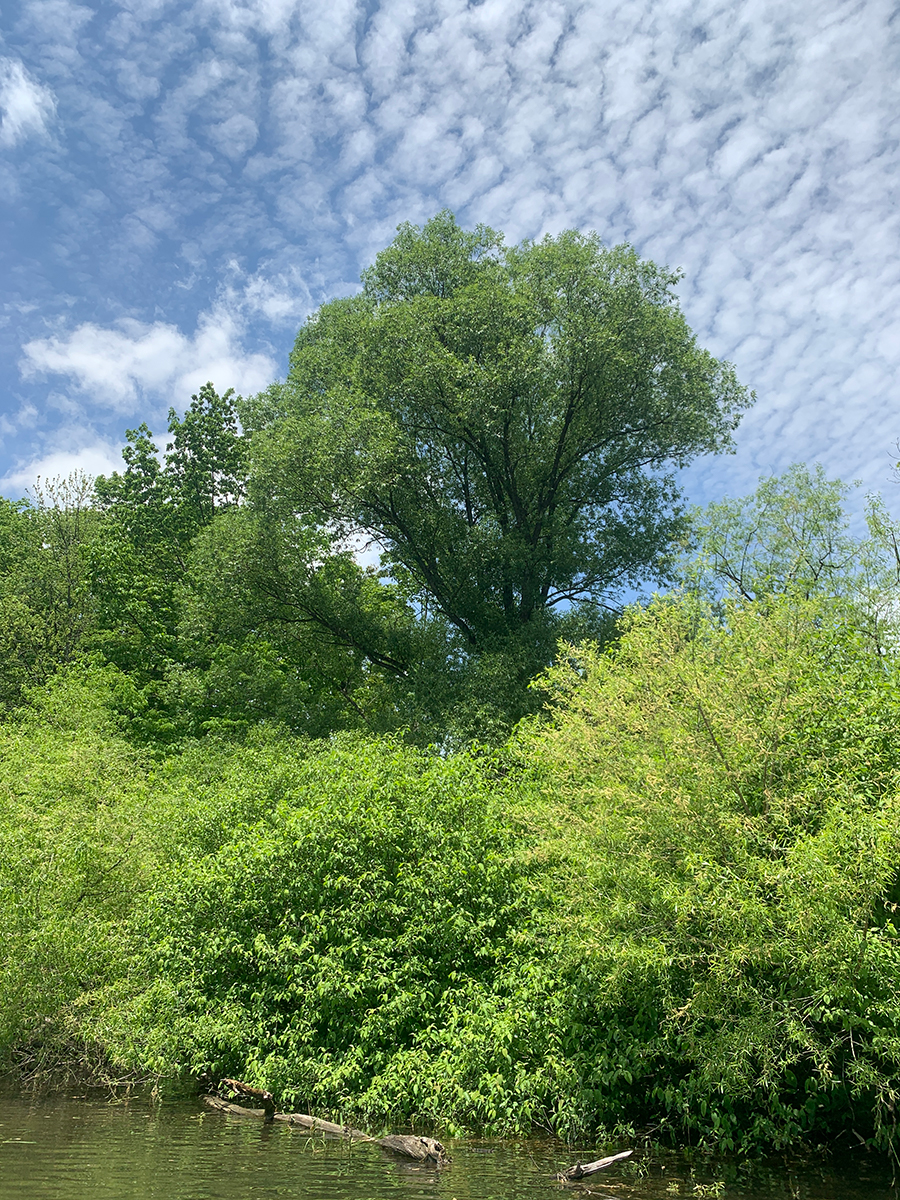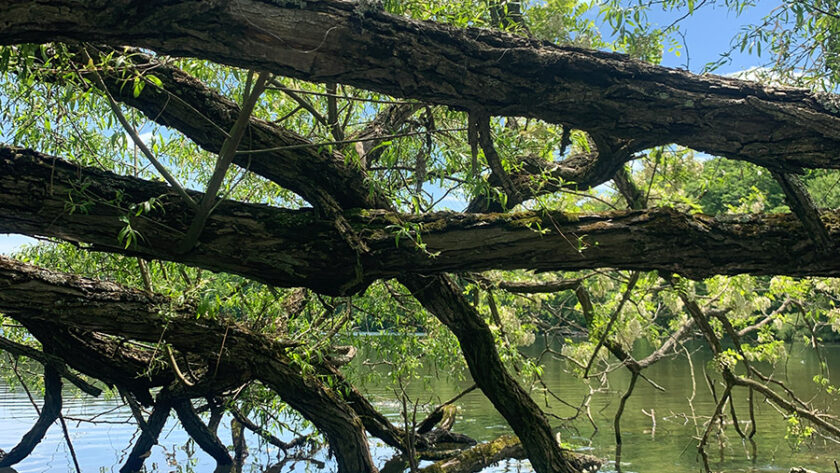One of my earliest memories was of three ancient black willow trees that were down by a little creek where I lived. Although we lived on a busy crossroads in town, the stream and willows in the backyard were a quiet place, guarded by those three old willows. They looked like gnarled old women, sitting by the edge of the stream, their long branches swaying gently in the wind. When the stream waters would rise, sometimes they would look like they were wading there, branches swaying in the current. The Black Willow is an incredible tree, the largest Willow native to North America, and a great tree to get to know.
The Black Willow is also known as the Swamp Willow, Sauz, Dudley Willow, or the Gulf Black Willow. It is native to all of Eastern North America, from the lower edge of Maine the entire way to the top of Florida, and across into Texas and into the upper midwest. A second area where Black Willow is native is scattered throughout California and New Mexico. A true North American tree, the Black Willow is a delightful tree to get to know and work with!
This post is part of my Sacred Trees of Eastern North America series–here you can learn about the many wonderful trees upon our landscape. In this series, I explore the magic, mythology, herbal, cultural, and divination uses, with the goal of eventually producing a larger work that explores many of our unique trees located on the US East Coast (which I hope to have completed by early 2022–so you will be seeing a lot more tree posts!) For my methods using ecology, the doctrine of signatures, and human uses, you can see this post. Other trees in this series include Tamarak, Dogwood, Spruce, Spicebush, Rhododendron, Witch Hazel, Staghorn Sumac, Chestnut, Cherry, Juniper, Birch, Elder, Walnut, Eastern White Cedar, Hemlock, Sugar Maple, Hawthorn, Hickory, Beech, Ash, White Pine, Black Locust, and Oak. For information on how to work with trees spiritually, you can see my Druid Tree Working series including finding the face of the tree, seeking the grandmother trees, tree relationships, communicating on the outer planes, communicating on the inner planes, establishing deep connections with trees, working with urban trees, tree energy, seasonal workings, and helping tree spirits pass.
Ecology
Black Willow is North American’s largest native willow species, with over 100 native willow species growing here (and nearly 300 willow species globally). An ancient Black Willow is quite a sight to behold! The Black Willow is often found as a solitary tree, growing as a single tree or in small groups of Black Willow Trees. Black Willow is shade intolerant and prefers wet areas along streams, rivers, lakes, and swamps. Black willow reaches heights of 100 feet or more and can get 3-5 feet thick when old. Black willow prefers to grow at or just above the water level, where it is happily subjected to seasonal floods.

The tree has a rather gnarled and chaotic appearance due to its growth habit–many young suckers and branches grow out of the tree and then, as the floods come, the branches break off and can take root anywhere along the waterway. As a tree that lives on the edge of waterways, its branches are purposefully brittle and as they break off, then they can be moved by the water and can sprout and take root at later points on the waterway. The other way the tree reproduces is with a seed crop, which female trees can produce each year. Black willow is dioecious, which means that it has separate male and female trees. To germinate, the seeds must be in full sun with soil that is very wet or flooded. If they have these conditions, they can grow three or more feet in one growing season.
Because Black Willow can easily handle floods and wet conditions, black willows are able to develop water roots in extremely wet conditions. In drought conditions, black willows stop branch and root growth until the waters come again.
In the spring, the Black Willow flowers early, usually with the emergence of the first new leaves. All Salix species have at least two kinds of leaves–the first leaves that come out from the bud (called “preformed”) and as the branch exhibits vigorous growth (common in a season), the new leaves are called “neoformed” leaves.
According to John Eastman in The Book of Swamp and Bog, Willow serves as a core species for an incredible number of species, including many kinds of pollen eating bees (honeybees, bumblebees, and solitary ground-nesting bees), many kinds of beetles, and butterfly caterpillars including tortoiseshell butterflies, moth caterpillars, and fly larvae. If you see a tree with large galls, this is likely a result of Crown Gall or Canker (which lives in the soil). These cankers are particularly problematic in dry/drought conditions and severely affected willows can be even more gnarled in appearance.
A primary ecological function of Willow is erosion control, as Willows live right along the water’s edge and can handle flooding, the Willow stands strong and holds the soil back with her extensive root system.
Human Uses: Food and Wood

The Black Willow is the only native willow in the United States to be commercially used as a timber tree. Its uses include furniture, shipping containers, fishing nets, and even artificial limbs (wooden legs, wooden hands, etc). The wood of the Black Willow is extremely lightweight, has good shock resistance, and does not splinter easily, making it ideal for certain applications. In an emergency situation, the inner bark of the willow can be used as a food source, but it is very bitter and unpalatable.
Charlotte Erichsen-Brown notes a very extensive set of uses for Black Willow among Native American tribes and early white settlers in North America. Due to its extremely flexible nature, the branches of willow were used to make a variety of tools: snowshoes, baskets, fishing nets (the inner bark of the willow makes a very nice thin twine), bows, and more. Even today uses of Black Willow and our other native willow species can be seen in the bushcraft community for making baskets, mats, snowshoes, sleds, and more.
When tobacco was scarce, the Ojibwe smoked black willow bark, which is very astringent and thus, would produce very good smoke. The Micmac-Montagnais used Black Willow root as a source for black dye.
Today, Black Willow is used for a wide variety of land healing, remediation, and restoration techniques. The first use is in erosion control. Riparian zones (zones next to rivers/streams that are prone to flooding) are a major source of focus for conservation today, especially due to the ongoing and significant loss of topsoil due to industrial farming practices. Because of its flood resistance, Black willow is an excellent choice to be planted along riparian zones (along with other water-loving plants and trees like Sycamore and Black Elder).
The second use is in a wide range of remediation and phytorestoration techniques, particularly for the uptake of hazardous chemicals and heavy metals in soil and water such as lead, cadmium, or copper. Black Willow has been planted to help contain poisonous and contaminated water from landfills (according to one study). Willow has also been used to address Cadmium poisoning as a remedial plant. This is particularly true if the poisonous matter is well below the surface (Black willow is not as good as taking up surface-level toxicity, such as lead, as described in this study). Many different kinds of Willows are effective at this work, as this study shows. Black willow has also been used to remediate soils with copper toxicity. Finally, Black Willow also has shown promise as a chemical remediation tree–chemicals, like Bentazon, can be drawn up with Black Willow where they are exposed to the sun and broken down.
I find all of this recent research really important for the future of our planet. I am so thankful that the Black Willow is willing to work with us to do the “dirty work” of healing, literally taking the poison into herself, poisons that humans created and dumped so that the land can be clean for others. What a gift.
Human Uses: Medicine
Both Black Willow and White Willow (European) are one of the primary sources of salicin, the primary ingredient in Asprin. Salicin also can be found in black birch bark as well as wintergreen leaves. Salicins produce pain-relieving properties and continue to be used extensively in herbal medicine for this purpose. According to John Eastman, Salicin was first isolated from willow bark in 1829 and used to eventually, Asprin. Now, Asprin is chemically synthesized.
Beyond pain-relieving qualities, however, the Black Willow is distinct in its herbal medicine. In The Earthwise Herbal: A Complete Guide to New World Medicinal Plants, Matthew Wood indicates that Black Willow is bitter, dry, and astringent. It was often used as a sexual tonic including for the treatment of impotence, for nervous disorders, for ovarian pain during or before the menses, and for other estrogen imbalance. Black willow was also sued for a variety of other conditions including sores, ulcers, pain, rheumatism/arthritis, and more.
The bark is best gathered when the willows are in flower and the sap is flowing, but it can be gathered any other time there is need. If you gather it then, you can dry and store the bark in a cool, dark place till future need. Or you can produce a tincture, which can store indefinitely.
According to Charlotte Erichsen-Brown, as early as 1633, green willow boughs were brought into the home and placed around a person who was suffering from a fever to “cool the air” and help heal them. Traditional uses also included using the bark of black willow to create a poultice for ulcers and open sores, including those with gangrene. A decoction (strong tea) of willow was widely used to treat infections and for pain healing, as well as to wash wounds and external skin issues. Another use of Black Willow was a substitute for quinine (along with Flowering Dogwood).
Black Willow in the Western Magical and Folk Traditions
Willow as a tree species has a strong place in the global traditions, although Black Willow, in particular, is less known.
Two references specifically about Black Willow come from the American Folk Magic traditions. In Hoodoo Root and Herb Magic, Cat Yronwode notes that Willow can be used in controlling magic. A person goes and cuts a root from a willow tree at dawn, naming the person who they are working to control. The root is wrapped in red flannel with herbs and sewn up, then dressed with Hoyt’s cologne and carried. In New World Witchery: A Trove of North American Folk Magic, Cory Thomas Hutcheson notes the inclusion of willow in some spring tonic blends in parts of Appalachia, which obviously have a magical component. (Here in Northern Appalachia, the spring tonic blend is often dandelion root and sassafras root, so I had not heard of this!)

More generally, we have a great deal on the mythology and mystery of willow trees from Europe. For example, Willow is also one of the ogham trees. In The Wisdom of Trees: Mysteries, Magic, and Medicine, Jane Gifford notes that Willow trees are tied to moon magic, enchantment, and are also known as a tree of immortality for the willow’s ability to regrow a tree from a single lost branch. In Celtic Tree Mysteries: Practical Druid Magic and Divination by Steve Blamires, willow represents new life and freedom, and the fact that it sits on the borders of water may indicate an otherworld connection. He also notes that willow gives us the strength to be able to accept our own place in the broader world and do good with that position. The Celts saw the willow as a tree that was ruled by the moon, had feminine energy, and that could help people tap into their subconscious and experience visions.
The Magical and Divination Meanings of Black Willow
Pain Relief: Due to Black Willow’s use as a pain-relieving herb and tied to the broader human uses of the willow tree, Black Willow’s first theme is pain relief. When we are in pain, we can reach out to black willow, sit beneath her wonderful branches, and have some relief. If you
Aiding in the removal of Toxicity: Willow’s use as a plant to uptake and aid in the removal of toxicity is critical to the health of our world and ourselves. I see Black Willow as aiding is in removing toxicity both within and without. Just as Black Willow is able to work with us to draw forth positions in the soil, healing the earth, so can Black Willow help us work deeply to root out poisons in our own psyche and spirits. She is a powerful ally in this work.
Navigating the Subconscious: Tied to Willow’s watery placement and also tied to broader global mythology about the willow, the Black Willow may also help us better access and navigate our subconscious. According to Carl Jung, the subconscious can be accessed through dreaming, mandala work, active imagination (or what we druids might call journeying or astral travel), and also through creative practices. Willow can be a gateway to our accessing, expressing, and understanding the subconscious self.
Dear readers, I would love to hear more about how you’ve used Black Willow, your experiences with Black Willow, and anything else you’d love to share about willow trees!


[…] Sacred Trees in the Americas – Black Willow (Salix nigra) – Magic, Mythology, Medicine and Uses […]
We just purchased our first, young Black Willow from a native nursery in our area, and I am so excited to see your timely post! We have a creek in our back yard, and are committed to protecting and nourishing our small portion of it. Now I am especially excited to have our young willow planted amongst our sycamores, pawpaws, and other native trees. Thank you for your interesting research and advocacy for our Mother!
I love your writings and wish you well in your endeavors and spiritual blessings. I’m planting alongside a channelized creek bank that is beginning to have some erosion from heavy rains and flooding. An old black willow lives here, really down in the creek as the drop off is quite steep from the lawn. In the forties, this little creek was deeply cut into a very straight channel and lots of healing has been done to remediate this. Along miles of this creek that was channeled, it has now been released from this bondage and made to meander beautifully, as a stream should. And then planted in sycamores, oaks, and native wildflowers. I’m thrilled to see boneset and even a lone special vervain. All this work was done via the remediation work a company must complete on some land not necessary tied to the land it harmed. My little section of this creek was not included in this work. Years ago, I removed the blackberry and multiflora rose that had crowded the edge for many years and now am happy to be planting boneset, vervain, fothergilla, marshmallow, meadowsweet, and many elder cuttings. ( all FREE from a friend of large gardens from roots, or small plants or seeds) I’m using the way the bank has eroded as wonderful little niches, shelves of you will, for these plants to establish themselves, spread to their full majesty, and help hold the edge of the creek bank. Your writings are such a resource and fill me with such magical potential for the healing these plants can bring us. Blessings, love, peace thank you. MollieCedar of the Swannanoa Valley of the Appalachian Mountains.
Hi Mollie,
Thank you so much for sharing! I’m so glad to hear the story of your creek and how it has been healed. We have so much healing work here to do in the Appalachian mountains–I’m so glad you are in these wonderful mountains as well! It sounds like you are doing amazing work! It is such a beautiful experience to tend a stream :).
[…] https://thedruidsgarden.com/2021/08/08/arboles-sagrados-en-las-americas-black-willow-salix-nigra-mag… […]
I have a black willow that grows near a creek I live by. I’ve just recently started working with her sprit! So far she is an amazing teacher! I’ve already grown much as a person as a witch.. She has relieved me of so much pain not just physical pain either… I’m certain she is a spirit guide of mine! She came to me when I was in need of her particular healing Qualities she is very powerful and I’m grateful for her!
Hello Alexis! I love this story of the black willow–she is such a pain reliever. I’m so glad to hear that you are cultivating a relationship with her. You might ask her what she would want in return for all of her help! Blessings to you and your willow!
I found big willow by the river in small town minnesota… turns out its biggest black willow tree in north america… clearly shouting at my inner self Cuz of the timing’s… I wanna see a stone artifact with black willow painted pictographs… found a big agate too its 161 pounds but this is only a whisper in their ears. How important exactly historically are black willow trees to the pre Columbas Americans?
Hi Ted, that is an amazing story about finding the largest black willow! What an amazing find!
The Willows are very important to pre-Colonial America–for their medicinal properties (salicylates, tannins) and also their many craft uses (basketry, etc).